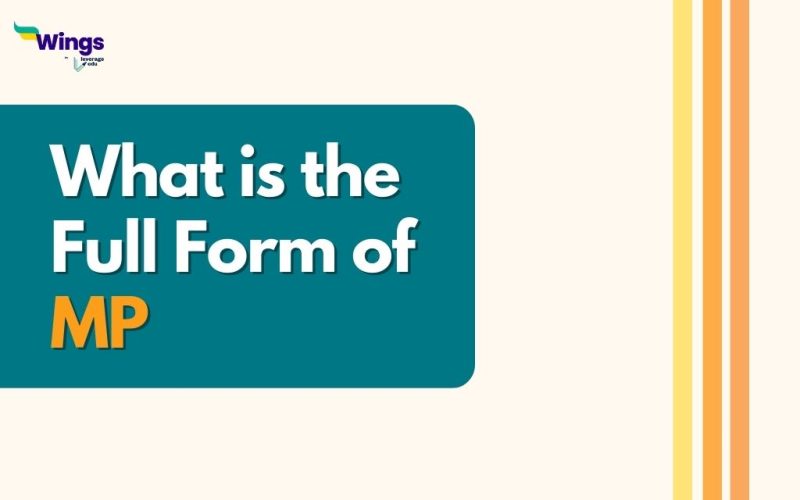The full form of MP is Member of Parliament. A politician who serves as a representative for a specific constituency is known as a member of parliament (MP). In many countries with bicameral legislatures, this expression refers to members of the lowest house, as higher houses may have a different title. When a member of parliament is elected or selected via an electoral list, he or she represents an electoral district known as a constituency. In India, a member of parliament is someone who belongs to either the Lok Sabha or the Rajya Sabha, the two houses that make up the Indian Parliament. Let us get to know more on MP full form and its details.
Also Read: Functions of Parliament
Member of Parliament (MP) in Lok Sabha
The Lok Sabha, also referred to as the Lower House of the Indian Parliament, currently contains 543 seats. These seats are directly chosen by the people from every state and union territory’s electoral district using the first-past-the-post voting system. Additionally, the members of the Lok Sabha are the voice of the Indian people. There is a direct voting process for the election of Members of Parliament.
The Indian Parliament is made up of two chambers: the Rajya Sabha, or Council of State, and the Lok Sabha, or House of the People. This arrangement classifies India’s parliamentary system as bicameral. The highest limit for the Lok Sabha is 555 seats, with 530 seats allocated to various state constituencies and 20 seats designated for union territories, all chosen by direct vote.
Between 1952 and 2020, members of the Anglo-Indian community were granted two seats. This tradition has since been discontinued. The party or coalition that secures the majority in the Lok Sabha is responsible for appointing India’s Prime Minister.
Member of Parliament (MP) in Rajya Sabha
The Rajya Sabha, also known as the Upper House of India’s Parliament, is made up of Members of Parliament who are elected to represent the Indian states. Additionally, it includes members selected by an electoral college that consists of representatives from state and union territory legislative assemblies, as well as individuals appointed by the President, based on their achievements in various areas.
It has a smaller number of members compared to the Lok Sabha and possesses less power in making decisions. As of 2022, the Rajya Sabha is capped at 250 members, with 229 of them representing states and the remaining 9 representing union territories like Delhi, Puducherry, Jammu, and Kashmir.
Furthermore, the President acknowledges the achievements of 12 individuals in fields such as arts, sciences, literature, and social services by nominating them to the Rajya Sabha. However, these members serve a term of six years and are not subject to dissolution. Nonetheless, one-third of the members retire every two years, leading to the replacement of these members through elections or Presidential nominations.
Moreover, the number of representatives from each state is determined by its population size, with Uttar Pradesh holding the highest number of seats due to its large population. However, the party that secures the majority in the Lok Sabha forms the government, either through a coalition or an alliance, serving five years in the Lok Sabha and six years in the Rajya Sabha.
When a position is left empty, the voting occurs. This happens within a span of six months, and the newly elected individual will only hold office for the rest of the term. Nonetheless, the laws of the Constitution and Parliament set the total number of seats in each chamber.
Also Read: Best Political Science Books
Eligibility Criteria to Become MP
Here are some of the criteria that candidates have to fulfil in order to become a member of parliament in India:
- Candidates must be citizens of India.
- Candidates cannot be under the age of 25.
- Candidates must be morally upright people.
- The court cannot sentence candidates to two or more years in prison.
- To be eligible to vote in any Indian parliamentary district, candidates must be registered.
- To be nominated, a candidate from a recognized political party needs to have one proposer from their district.
- In order to run alone, a candidate needs ten proposers.
- Candidates must offer a 25000 rupee security deposit.
Also Read: Features of Democracy
Grounds for Disqualification
There are specific grounds for disqualification, just as there are some requirements for a candidate to become a member of parliament. Let’s examine it now.
- Holds any profit on behalf of the Indian Government (apart from a position authorized by the Indian Parliament)
- In case a candidate is unstable and mentally
- Ceased to be an Indian citizen
- Any law approved by the Indian Parliament forbids them from doing so.
- If a candidate has a history of being convicted of bribery
- Has been penalized for supporting or participating in social violations including dowry, untouchability, or sati
- Has lost their job as a result of dishonesty or state corruption
Popular Full Forms
We hope this blog has helped you understand the MP full form and everything related to it. If you want to know more, find the 300+ full forms list on our blog. In the world of short forms, you can rely on the Leverage edu page to know about more full forms like this! Connect with us study abroad experts to achieve your international dream today!
 One app for all your study abroad needs
One app for all your study abroad needs













